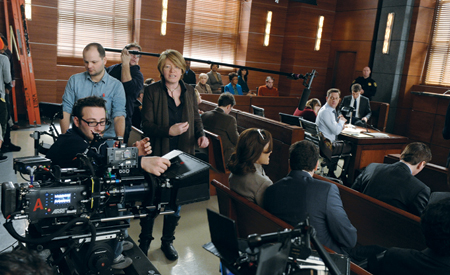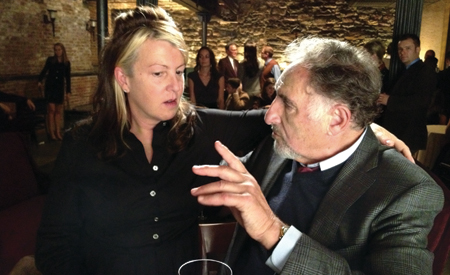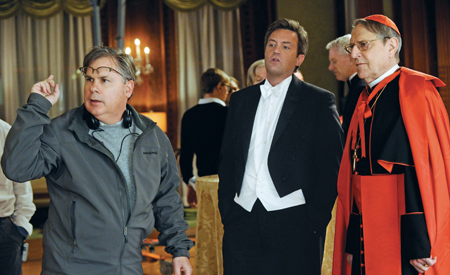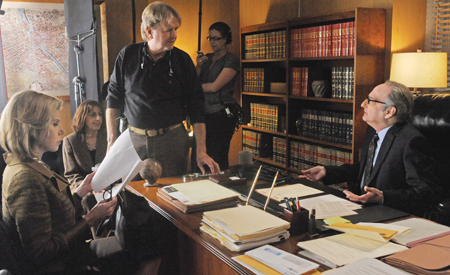By ANN FARMER
Brooke Kennedy sits in her director’s chair on the set of The Good Wife one morning in late February. The wind outside is billowing sheets of rain. But no one pays any heed as the cast and crew intently block a courtroom scene for an upcoming episode that is partly based on an actual rape case involving a victim championed by online “hacktivists.” Kennedy stares at the three television monitors in front of her, each dedicated to a different camera in the next room. All three monitors exhibit a similar effect—the foreground and background of the shots are deliberately blurry. Only the middle ground of the frames is clearly in focus. The shots feel crowded and oblique, giving the impression of a prying eye—exactly what Kennedy wants.
“OK, lots of good stuff,” she says, striding onto the courtroom setup at the conclusion of the take. “You’ve got too much shoulder,” she tells one camera operator. “Less shoulder next time.” To another, she says, “You know what? That was perfect. Do something different next time.” To guest actor John Glover, playing the defense attorney, she says, “Just a little bit more of a surprise,” referring to his reaction at a sudden turn of events in the courtroom (no spoilers here).

JUSTICE SERVED: Executive producer-director Brooke Kennedy says she expects episode directors to show up prepared to make their case and assume a leadership role..
After she’s finished giving notes and slips back into her seat, Kennedy, who is also an executive producer of the series, explains that to coax the cast and crew’s best work, “The less words I use, the better. They come to this business because they want to contribute to storytelling, not be told what to do. I try to convey my narrative and let them run with it.” It is a collaborative approach she wants from all the directors. “Everybody brings a talent,” says Kennedy. “As the director, you try to orchestrate the talent.”
The directors’ skill at conducting these episodes is one of the reasons the series succeeds in being more than just another legal drama. Co-created by executive producer-writers Robert and Michelle King, the cast and series (now in its fourth season) have earned a Peabody Award and 25 Emmy nominations. Its deft scripts demand serious comic chops from the directors, and the show’s elegant mien requires their skill at composing shots that push the storylines while maintaining a classical look.
The series has also gained a reputation as a smoothly run operation, for which Kennedy must take a chunk of credit. Brought on at the start of the first season, she serves as the primary liaison between the East and West Coast branches of the operation. The Kings live and work in Los Angeles, where the series is written and edited. To accommodate its star, Julianna Margulies, who resides in New York, the show is shot at Broadway Stages in Greenpoint, Brooklyn, where Kennedy largely supervises the production for the Kings. “I’m their General Patton,” jokes Kennedy, who is known for caring enormously about the show and staff, while being unafraid to make tough decisions. “I make sure the war is won.”
Kennedy, who serves on the DGA’s Eastern Directors Council, began her career almost 30 years ago as a unit production manager on Miami Vice. She subsequently produced numerous primetime series, most recently Fringe. She estimates that she’s prepped 250 directors over the years, including Michael Zinberg and Rosemary Rodriguez, who have directed the most Good Wife episodes to date. (A few dozen directors have rotated in that slot.) Kennedy says, “I expect leadership, first and foremost,” in particular, their ability to walk onto a new set, quickly read the room, and take the reins without offending anyone.
“It’s all about prep,” she says, explaining that directors get seven days to prepare for their nine-day shoots, beginning with a bicoastal concept meeting on day one that unites the writers and post-production supervisor on the West Coast with the production team on the East Coast. “That’s when we hopefully have deep conversations about what the script is about,” says Kennedy, “and how to accomplish it.” To facilitate the long distance exchange, a Polycom teleconferencing setup allows everyone to see everyone else. Together they pinpoint any obstacles or concerns about the script’s logistical demands. “You try to put as many variables out on the table as you possibly can,” says Zinberg, a veteran director whose career began with The Bob Newhart Show and spans at least 80 other television series.
After that, the director goes to work with the various department heads, including props, casting, and costumes. Foremost is the need for locations that support the sophisticated, high-end look of the show and satisfy the camera and lighting requirements. The 1st AD breaks down the scripts and generates schedules. Denis Doyle, who alternates with the other 1st AD, Colin MacLellan, explains that once they start shooting: “I run the set, and I give it some direction so that the director can concentrate on the more creative aspects. I keep things moving.”
But before any of that can happen, on the final day of prep, a smaller group on both coasts, most importantly, the director and writers, sit down via teleconference for a critical tone meeting. They comb through every scene to ensure everyone’s on the same page. “Our characters are often very sarcastic,” says Robert King, “and if that’s not coming through, you would lose the irony of the scene.”

ACTING UP: Rosemary Rodriguez (top), with Judd Hirsch, likes to research the theme of the episode. “Whatever I can do to make the story come alive, that’s what makes it fun.”
Rodriguez, who has directed episodes of Rescue Me, Blue Bloods and Elementary, says that a bicoastal series can complicate matters. “In other shows I’ve done, it can become a battle between New York and L.A.,” she says, explaining that tension can arise when something is written into a script that the production side doesn’t feel is logistically possible. As far as The Good Wife is concerned, though, she says it is “all like a dream because we all work so well together.”
Zinberg, a calm, seasoned pro on the set, agrees: “The Good Wife is as good as it gets. When you come in as a director on that show, you know that you’re going to be surrounded by an amazing group of people who are genuinely interested in what you have to bring to the party as a director.”
That includes making their mark on an episode. “You get a script, it speaks to you, and you find a way to make it yours,” says Kennedy, who had an immediate reaction, for instance, when she read the hacktivist script. “I got the impression of a Michael Clayton,” referring to the suspenseful 2007 feature. That feeling was her inspiration to shoot the courtroom scene with a heightened sense of intrigue suggested by the camera’s probing point of view. “It’s what’s in the white, not in the type,” says Kennedy, referring to how the scripts provide elbowroom for the director and actors to tweak the drama and, even more so, the comedy, when appropriate.
“Maybe we’ll play it a little funnier in this take and take a little bit of it away in that take,” says Zinberg, “so there are options in the cutting room.” He says the actors are always game to work a scene. When he was recently directing “The Seven Day Rule” episode, for instance, he had a lot of fun with Margulies’ character, Alicia Florrick, who was finally offered a chance to become an equity partner in her law firm. To celebrate, she goes on an expensive shopping jag during her lunch hour. She then learns that she’s expected to invest $600,000 in the company. Senior attorney, David Lee, played deliciously by Zach Grenier, stops by her office and casually drops that little bomb, leaving her gasping. “She’s sitting there pondering it,” says Zinberg “and at exactly the right moment she looks at the bags and says, ‘Oh my god, I’ve got to return everything,’ and snatches them up. When you have those opportunities to play the timing, I believe it’s the small beats that make the show so special. Finding those gems in the attitudes, in the writing, and in the characters’ relationships makes the show wonderful to watch.”
There is certainly a high caliber of talent to work with on the show, including such guest stars as Michael J. Fox and Martha Plimpton, who won an Emmy for her guest appearance. More often, says Zinberg, “the challenge is not to direct toward their talent,” but to work counter-intuitively. “Nathan [Lane] is an interesting example,” he says, referring to how the comic actor normally gets typecast in flamboyant, bigger-than-life roles. “We wanted him to be small in this part. We wanted him to be controlled as a character. And man, he hit it out of the park. He’s working small, big, if you know what I mean,” says Zinberg, adding that he learned an important early lesson directing Bob Newhart: “Not to be afraid when you recognize something as funny. Don’t run away from the comedy. And a good comedic moment, inherent to the scene, will only add to the scene, not take anything away.”

CHURCH AND STATE: Series creator and occasional director Robert King (above left), with Matthew Perry and John Cullum, says he loves collaborating with the show’s directors. (below) VETERAN STYLE: Director Michael Zinberg helped create the show’s Altman-esque look, “a symphony of conversations” with the camera following one person out of one scene into another

King still recalls the time he watched coverage of a scene being directed by Rodriguez and his angst when an actor flubbed the humor in a line he’d written. “There is nothing closer to having your heart cut out and stomped on in front of you than to see your joke poorly told,” he says. Then he watched as Rodriguez walked over and leaned into her ear. On the next take, the actor delivered it perfectly. “Rosemary is a great performer’s director,” says King. “With a whisper and not too much direction she can whip a shot into shape.”
A snap zoom, a deliberately jerky cam, even a Steadicam move at the wrong moment “can kill a joke,” says King. Which is one reason that the show’s producers prefer directors who are adept at conveying a smooth, cinematic style that’s in keeping with the suave, heightened reality that these characters exist in. It’s set in a Chicago law firm “where everyone is in six-inch heels,” says Kennedy, “and look as good at ten at night as they did at seven in the morning.”
To convey this, the directors are expected to compose elegant compositions that flow from one scene to the next. “I love collaborating with the directors,” says King, who has directed three episodes. Too often, he says, courtroom scenes in legal dramas are shot with a lot of predictable cutting back and forth between the prosecution and defense. “Michael Zinberg,” King says, “is the one who provoked us to create this Altman-esque Nashville sense of moving from one conversation to another.” In an early episode he “created a kind of symphony of conversations, where the camera would follow one person out of one scene into another,” influencing the look of all the episodes that followed.
King also admired the way that Rodriguez shot the “Blue Ribbon Panel” episode, which presented Florrick as an outsider and the only woman on a citizens’ review panel investigating a police shooting. “She was very smart at using the camera to show someone as an underdog,” says King, describing how Rodriguez effectively blocked the scene with Margulies positioned at the edge of the frame, sitting at the tail end of the half circle of male civic leaders and looking almost invisible to them. Until she asked a politically charged question and all the men’s heads turned, a synchronized wave of them, to take her in. “I thought it was brilliant,” chuckles King.
Although many scenes take place inside courtrooms, Kennedy says it’s not especially important that the directors fully grasp all the legal protocol. However, she recalls with amusement one director who had never been in an American courtroom and kept asking for tablecloths to spread on the judge’s table. But part of why directors direct, says Kennedy, “is they like going into a world they would not normally go into.”
Rodriguez always bones up on her episode’s theme. If it’s a story about predator drones, “I immediately Google predator drones,” she says. She had never heard of the Blue Ribbon review panel, which she discovered actually exists and shared that information with the cast. “Whatever I can do to make this story come alive, that’s what makes it fun for me. And it’s better when everyone knows the stakes involved.”
To save time, the directors will often resort to block shooting where they light and do all the wide, medium and close-up shots in a scene from one character’s perspective. Then the crew will swing around and shoot the scene from another angle. This avoids the seesaw of having to re-light and re-position the cameras so much. During “Blue Ribbon Panel,” Rodriguez took the tactic one step further. She asked the actors to do quick costume changes and continued shooting scenes from other days in the same direction to pick up even more time. Thus, parts of scenes were shot out of sequence. “It’s not easy for anyone to keep track of,” says Rodriguez, who, along with the script supervisor, is responsible for monitoring the actors’ performances so that all the cuts edit seamlessly.
Kennedy says all the directors on The Good Wife must be adept at making adjustments on the fly. “Directing is easy when it goes right,” she says. “It’s when it goes wrong,” when a light doesn’t work, or an actor can’t get his lines, or a location goes up in smoke. “It’s all about when it goes wrong.”
Rodriguez had one of those days when she was geared up to direct Archie Panjabi, who plays private investigator Kalinda Sharma, in an action sequence that Rodriguez had painstakingly plotted as one long take. Rodriguez’s game plan was for Panjabi to stride up to a colleague’s vehicle with a bat and shatter each of his car windows, one at a time. “I was explaining, she’s going to do this one and this one and come around and do that one,” says Rodriguez, who even had Panjabi test wield her bat on another car window first, “and boom, it just smashed right away.”
For some reason, though, when it came time to do it for the cameras, no matter how hard she swung, Panjabi could not get the windows to break. “We tried different things,” says Rodriguez, who found out later that these particular windows were made of a super strength glass. “We kept trying to put different things on the end of the bat. We just kept trying; it was really frustrating. It was very disappointing for me not to get it exactly how I wanted it,” says Rodriguez, who finally came up with a solution. Panjabi first slammed her bat against a window and then a stunt man would come in behind her and finish the deed. “We jumped around a lot in the editing room.” Later she learned that the scene became a fan favorite. “In the end,” says Rodriguez, “she looks kick-ass, anyway.”